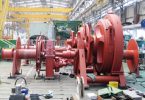Scavenge fire:
Scavenge air flows from scavenge manifold to under piston scavenge space. The air from the scavenge space flows into the cylinder through the scavenge ports.
For a scavenge fire to take place, there has to be a combustible material, air(oxygen) to support the said combustion and a high enough temperature to trigger the said combustion. The combustible material in this case comprises oil / oil-residues originating from the following sources:
- Cylinder oil drained-down from the liner / piston-ring surfaces
- Crankcase oil brought up by the piston rod while reciprocating, because of a faulty stuffing-box
- Oil residues / unburnt oil. These residues may come from defective fuel injectors / injectors with faulty pressure of opening
- Cylinder lubricating oil/fuel oil striking the cylinder and then running down to the scavenge space
The air (oxygen) necessary for combustion is readily available from the scavenge air which is available in abundance (through turbocharging) for the operation of the very engine. The source of heat for triggering the ignition comes from various sources like, piston blow-past, slow ignition / afterburning or exhaust-back pressure (causes a blow back through the scavenge ports). Poor combustion-performance is one of the broad causes which lead to scavenge fires.
Causes of scavenge fire:


